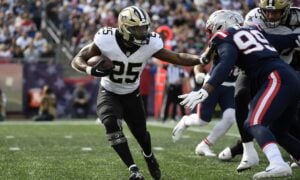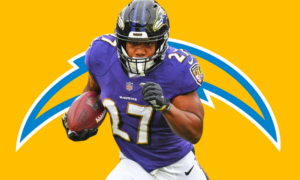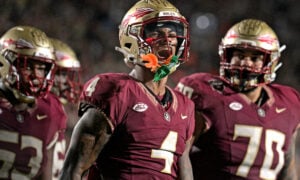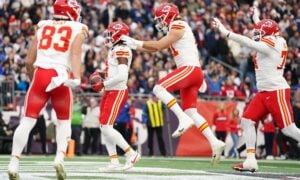Dynasty Day Trading: Creating Portfolios and Determining Player Dividends
Dynasty fantasy football is routinely compared to playing the stock market. You invest in a player, hoping that the returns he gives you, in the form of points, justify that investment. On the surface, the comparison makes sense because the stock market is something many people intuitively understand. There is one problem with this direct comparison though.
It’s all wrong!
Stocks don’t work like what I described above. You don’t buy a stock, hold it and directly reap some monetary reward for it, with the exception of stocks that pay dividends, which I’ll address later in this piece. How stocks are actually valued is by market perception and, the aforementioned, dividend yield. There have been other dynasty articles that outline how dynasty owners should view players in a similar manner to stocks, however, as far as I’ve been able to tell, none really do precisely what they are advocating. I say that because the tools many of us use only paint half of the story.
For instance, Average Draft Position (ADP) is where a huge percentage of dynasty owners turn when trying to determine the value of a player. The problem is ADP is a snapshot in time and doesn’t provide any context in terms of how a player ended up with at that value. Trying to discern value this way would be akin to a stockbroker looking at only the price of a stock, foregoing any research into the recent pricing of the company, and making a decision to buy or sell that stock based on the price at that moment. Suffice to say, that stockbroker wouldn’t be in business long.
Stocks, like players, are only worth what someone is willing to pay for them. With stocks, pricing is a bit easier to determine as the market price is listed front and center and is derived from actual trades that executed at that price during the specified time frame. Basically, if someone just bought a stock at $4.50 per share, then that is now the market price. The market does a very nice job of determining a collective value. The dynasty community does this as well in the development of ADP. The question is, how can we mold ADP to fit into a more traditional sense of value that we are familiar with when investing in the stock market?
[am4show have=’g1;’ guest_error=’sub_message’ user_error=’sub_message’ ]
Where many writers who have broached this subject in the past have gotten it wrong is in the need to track players like we track stocks, in a portfolio that tracks their value over time and through trend analysis, not just static prices. There are a lot of moving parts in this explanation so let me list what we need and then I’ll detail how we get there:
- A player price, where the higher the price, the more the market values that player
- A method for tracking value over time and not simply referring to value snapshots
- A way to equate the market’s perception of player value to how he produces in our league scoring format
Price Check
When determining the quasi-price of a player, ADP gets us almost completely to our goal. However, for our needs what we would do is take the total number of players in the market – let’s use 500 as an example – and subtract each player’s ADP from that number. For example, Todd Gurley currently sits atop the ADP rankings as the top drafted player, so his price would be (500 – 1) for a price of 499.
Once we get the current prices for all the players, we will want to do the same for past snapshots as well. MyFantasyLeague keeps two-week intervals of ADP that include the current rookie class going back to May 1 of this year. We will determine the price of each player for each of those intervals as well, giving us a way to see each player’s market value over time.
Gurley, for instance, started off eight weeks ago with a price of 498 and held that value until increasing to a price of 499 four weeks ago, a price he has held since then. What we could say then is that Gurley’s value has increased .20 percent over the past two months.
Conversely, Saquon Barkley, the top drafted player in this rookie class has actually seen his price drop somewhat over that same time period, starting off at 499 eight weeks ago whereas his current price is 496, a -.60 percent drop in his value. This is somewhat expected as rookie fever begins to wear off across the community and rookie valuations begin to settle. Barkley’s slight decline in value isn’t isolated just to him: nearly every rookie in this class has seen their price dip over that period.
Keeping Track of Your Assets
So now that we have a way to put a market price on each player, we need a way to determine if our players are being perceived as gaining value or losing value since we acquired them. To track value gained or lost on held assets over time, stock enthusiasts use what is called a portfolio. The portfolio generally includes the price at which a stock (or in this case a player) was acquired, the current price of the asset, value gained or lost since acquisition and the number of shares held, a feature we don’t need to be concerned with for this exercise.
Fortunately, most fantasy sites provide us with ways to acquire much of this data. Simply copy the names of the players on your team into a spreadsheet and determine the price of each player, determined from their ADP, on the date which you acquired them. Once you have your “purchase price” determine each player’s current price as well. With that information, you can determine the percentage value gained or lost since the acquisition date by taking the purchase price and dividing it by the current price. Additionally, you can determine if your team has gained or lost value as a whole by adding all of your player’s purchase prices together and dividing it by the sum of their current prices.
By creating a portfolio you can identify opportunities to possibly sell high on certain players and can even get a sense for how effective you are as a dynasty owner in terms of identifying, cultivating and taking advantage of changes in value.
Paying Dividends
As I alluded to at the start of this piece, dividends are another way to determine the value of an asset. In the stock market, some companies will pay a periodic dividend in order to keep investors interested in buy and holding their stock. How valuable that dividend is in relation to the price of the stock is determined by a simple formula which is:

As an example, let’s say that the company pays a quarter dividend of .10 cents per share while the current price of the stock is $4.50. To determine the dividend yield we would multiple .10 cents by four, since the dividend is paid quarterly, giving us a .40 cent annual dividend. We would then divide .40 cents by the $4.50 current share price, giving us a dividend yield of 8.88 percent, a very solid yield, meaning that 8.88 percent of the current stock value has been recouped, via dividend, over the span of the past year. This concept also will work as an additional way to help value fantasy football players in the same way that we value stocks.
The player dividend yield will vary from league to league, given the fact that the same player will score a different amount of points in accordance with each league’s scoring system.
Referring back to Todd Gurley for a moment, we know his current price is 499. In a league that I’m a member of, he scored 457.09 points last season, his dividend. To determine his dividend yield for this league we take his annual dividend, 457.09 and divide it by his current price, 499. This gives us a yield of .92 percent, meaning if an owner drafted or acquired him at this time last year, 92 percent of his value would have been returned last season. If Gurley scores even 40 points next season, then he will have paid a full repayment on the community’s perceived value of him.
Now, consider another player, Odell Beckham, who only played in four games last season due to an injury. He ended the season having scored only 77.05 points in the same league I mentioned earlier. Beckham’s ADP, and by extension his price, has dropped a few places due to the injury he sustained, some rumors of off the field issues and public disputes regarding his contract and desire to remain with the Giants. His price, as of the writing of this article, is 494. The lower point total last year, in conjunction with his high price, gives him a dividend yield of 15.6 percent which would mean that if he continued to score the same amount of points each year while retaining a consistent ADP, it would take just under six and a half years for him to reach his perceived value.
Tracking Value
Since there are no fantasy football specific portfolios that I’m currently aware of, I would recommend creating your own in Microsoft Excel. Each time you acquire a player via the draft, waivers or a trade, enter the acquisition price in this spreadsheet. Additionally, when you cut or trade a player, you would want to track the realized gain, or loss, in value to your team.
I would also recommend creating different tabs for each league you are in and routinely, I recommend every month or two, tracking the value of your team. You will see the cumulative value move up and down over time but, if you are doing things correctly, you should see the value of your team rise over time. In addition to tracking the value of individual leagues, it might make sense to track all of your leagues collectively so as to get a better sense as to how successful you are as a dynasty owner in identifying, acquiring and capitalizing upon spikes and dips in player values.
The NFL off-season is the perfect time to undertake such an exercise because as we all know, there is no off-season in dynasty fantasy football!
[/am4show]


































































